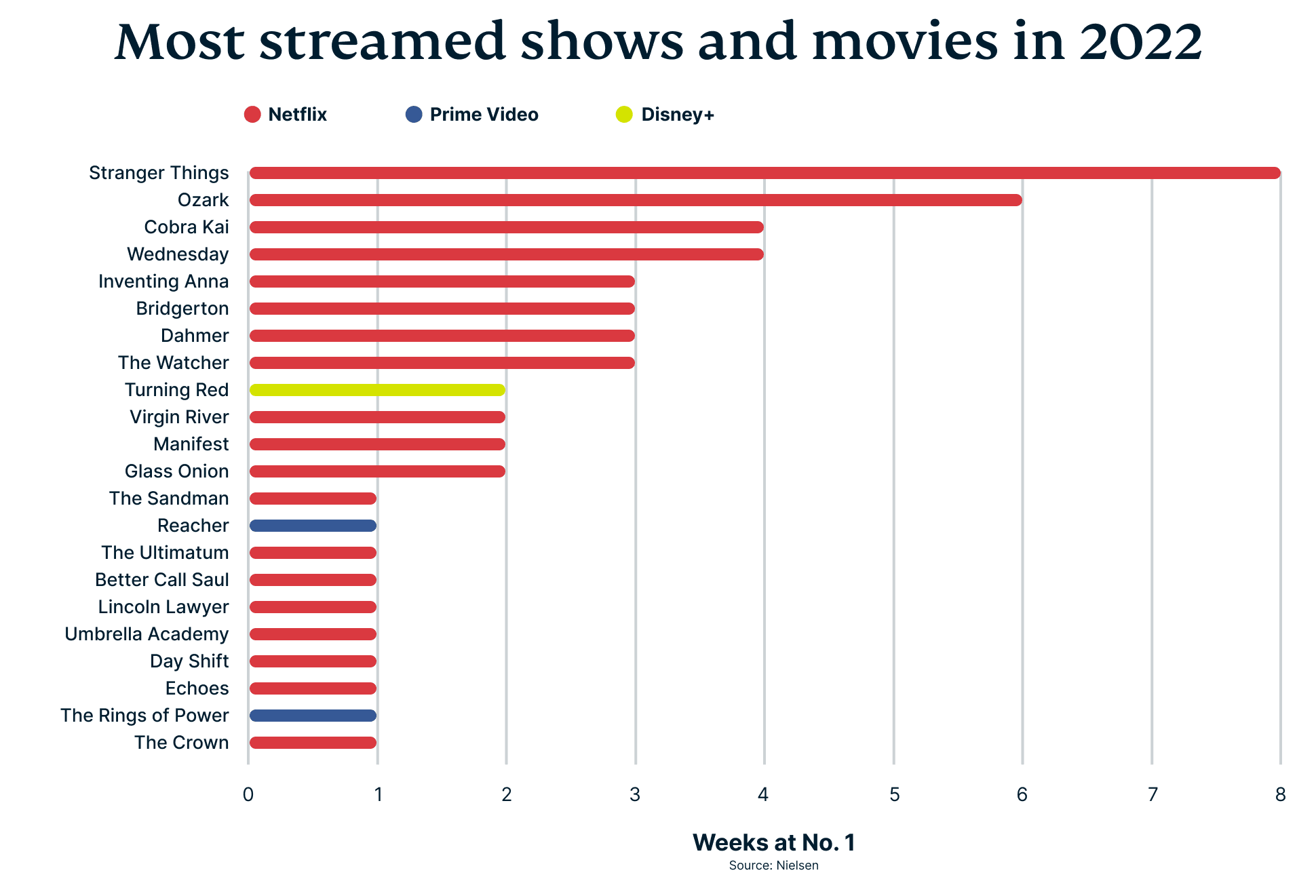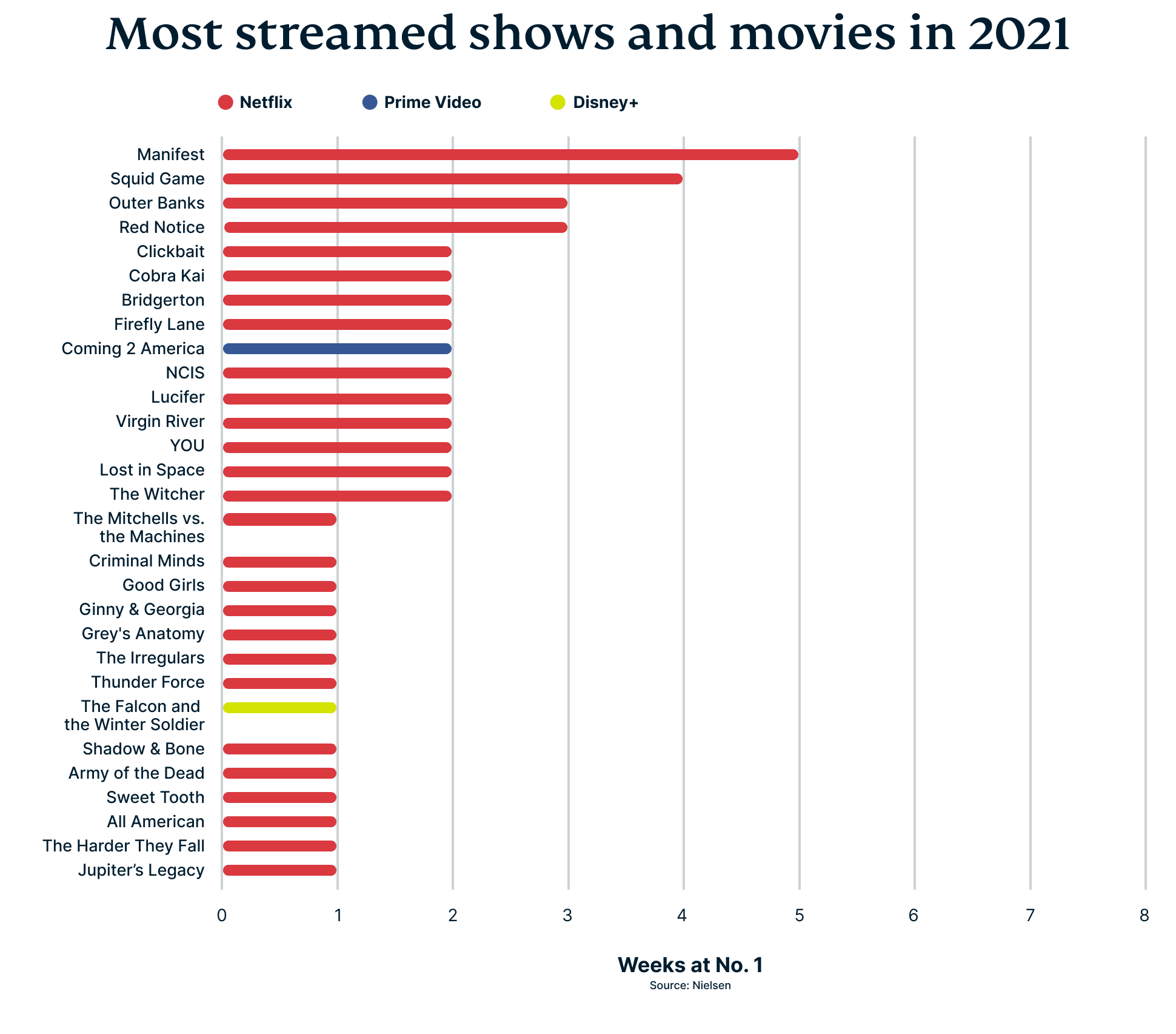
This post was originally published on November 7, 2022. Some streaming records have since changed and been updated.
It’s been an exciting year for the streaming industry, for Netflix especially, and for viewers.
After much was made in April about declining subscriptions for Netflix—the first time it lost subscribers in 10 years—the dominating streaming service released the fourth season of Stranger Things, which proved to be another turning point.
Stranger Things sat at No. 1 on the streaming charts for eight weeks, breaking nearly every streaming record out there.
[Love streaming? Get your fill of the most popular shows while staying private and secure with a VPN!]
One of those records was for Netflix’s most streamed English-language show in its first week. This particular record was broken in November by Wednesday, Tim Burton’s Addams Family spinoff. The show, featuring Jenna Ortega as Wednesday Addams, clocked in 341.2 million hours viewed during its first week, dethroning Stranger Things Season 4, which previously held the title. (If all languages are considered, the title still belongs to Squid Game with 571.8M hours viewed during its best week.)
The insane popularity of Stranger Things is credited with helping Netflix in the third quarter of the year more than regain all the subscribers it had lost in the first six months.
Relive 2022 streaming highlights by flipping through our gallery below. All stats in this article are based on Nielsen streaming ratings, which cover U.S. viewership of Amazon Prime, Disney+, HBO Max, Hulu, Netflix, and Apple TV+.
[evpn_canva id="DAFKyqZpIMY"]
It’s not just Netflix, and it’s not just viewership. New records were hit when it came to budgets, subscribers, streaks—you name it.
With a 715 million USD budget, Prime Video’s The Lord of the Rings: The Rings of Power became the most expensive series ever produced. The first two episodes broke Prime Video records, with more than 25 million people watching on the first day the series was released. In other Prime Video highlights, earlier in the year, Reacher became the first TV series created by the streamer to hit No. 1.
Netflix also set a budgetary record with The Gray Man, the most expensive movie made by the service to date with a cost of 200 million USD.
On Disney+, Doctor Strange in the Multiverse of Madness first did well in cinemas, and that was followed up with a strong showing when it was released for streaming, setting a Disney+ record for highest viewership in a program’s first five days. Disney+ was also the big winner for subscription gains, adding 26 million new subscribers in the year’s first half.
And it wasn’t all fantasy and adventure that captured our attention. Even Dahmer, a grim series about serial killer Jeffrey Dahmer, broke a record for the most watched new show on Netflix in its first week.
But perhaps the biggest milestone of all came in July, when streaming viewership in the U.S. surpassed cable for the first time ever, according to Nielsen. While streaming had claimed a larger slice of the pie than broadcast television for a while, this was the first time it exceeded both broadcast and cable.
One thing is certain: with more people turning off cable and broadcast TV in favor of streaming, more records are set to be broken—almost immediately.
The dominance of Netflix and ‘Stranger Things’
Of all the weeks in 2022 for which streaming viewership data is currently available (Nielsen reports numbers about a month after the fact), programs on Netflix held the top spot every week except four. Those weeks were won by Prime Video’s Reacher and The Rings of Power and Disney Plus’s animated film Turning Red.
Netflix’s dominance shouldn’t come as a surprise. But notably, the standout programs in 2022 were able to significantly dominate viewership, with Stranger Things claiming the top spot for eight weeks.
Looking back to 2021, a wider variety of shows made it to the top of the streaming chart, and the winning streaks were shorter. Netflix’s Manifest was at No. 1 for five weeks, and Squid Game for four.
While viewers watched a more diverse selection of shows in 2021, it is easy to see that it was a lower-quality year for streaming than 2022. One week, viewers chose to stream reruns of Criminal Minds on Netflix as there were so few shows anyone wanted to watch. In fact, Criminal Minds was the most-streamed TV show in 2021—even though the show had no new episodes that year. Other broadcast network shows like Grey’s Anatomy and NCIS topped streaming ratings as well.
Netflix still reigned. In the whole of last year, only three weeks were won by non-Netflix programs. These were Prime Video’s Coming 2 America and Disney Plus’s The Falcon and the Winter Soldier.
True crime captured viewers
True-crime documentaries and series focusing on the main villain came up tops, again and again, this year.
The Tinder Swindler, about Israeli conman Simon Leviev who used Tinder to meet and date various women before emotionally manipulating them into giving him money, became Netflix’s most-watched documentary ever.
Inventing Anna, a mini-series produced by Shonda Rhimes, tells the story of Anna Sorokin, who convinced New York’s elite that she was a German heiress to fund her lifestyle. The show was No. 1 for streaming for three weeks running.
Finally, Dahmer—Monster: The Jeffrey Dahmer Story, the mini-series about American serial killer Jeffrey Dahmer, reached the No. 1 spot on Netflix in its first week of release, with critics praising Evan Peters’ incredible portrayal of the famed criminal.
What's been your favorite show of 2022? Let us know in the comments!
Take the first step to protect yourself online. Try ExpressVPN risk-free.
Get ExpressVPN




















